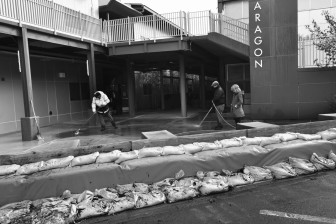
Starting overnight, the lower floor of the science wing flooded on Dec. 2. Teachers whose classrooms were affected moved temporarily into available classrooms, and cleanup was finished in time for regular classes to start again the next day.

Custodial staff was at Aragon to clean up the resulting water and debris as early as 6 a.m. on Wednesday Dec. 3. By seventh period, cleanup was nearly finished. “Getting the water out of the classrooms was our first priority,” says Ernie Carrasco, athletic fields and grounds technician. “[By the end of the school day], there was still residual mess, but we had cleaned up all the debris.”
In response to the flood, the district office sent additional custodial staff to help clean up the science wing. Including Aragon staff, the total number of people involved in cleanup numbered about 10, according to district equipment operator Tommy Damico.
Damico remembers the flood two years ago. “Last time was actually really bad,” he recalls. “This was the easiest cleanup. The one two years ago was like a rushing river that went through [the lower level of the science wing].”
Science teacher Arron Apperson’s first, second and third period Engineering and Technology classes were affected by the flooding because students couldn’t access the necessary software for their current project. “My class is way behind schedule [now],” says Apperson.
Apperson cites miscalculation as the reason the sandbags solution failed. “The issue for us is that they looked at it and saw a pond when it was actually a river. There’s not the same amount of water; a river is a pond going past every minute. There’s a totally different calculation you have to do, which whoever did this failed to take into consideration.”
While cleanup may have solved the issue temporarily, Aragon still faces a permanent problem. Two months earlier, Apperson’s Engineering and Technology class was assigned a project to help find a solution to Aragon’s flood problem, a solution that could alleviate the traffic situation in the parking lot as well. Students were tasked with fixing the immense flow of water through the lower level of the science wing during the rainy season. Previously a flowing river, the area has since been blocked by the expansion of the school and the parking lot.
Apperson says, “The issue is very straightforward. They put two buildings in the way of a historic creek, and now where the water used to flow, it needs to go around those buildings. This expansion keeps the excess water from being absorbed due to the asphalt, leaving little space for such build up to go anywhere but down the hallway.
This, of course, poses a problem. Apperson says, “We have a flood that happens whenever we have half an inch of rainfall in an hour, and it leaves the ground completely saturated. This is not a trivial event given our current location and climate.”
The district’s temporary solution consists of hay bales and tarps meant to redirect the water.
Apperson adds, “It’s not exactly the same [as last year]. You can notice there’s only one stack of hay bales in places where there were two stacks before, and so it’s not quite as high as it was last year, and the plywood isn’t in the same place. It’ll be interesting because it’s been modified, but probably not by an engineer.”
This recurring problem opens up opportunities for new ideas. Apperson’s project asks each student to devise a permanent solution under the current temporary solution’s cost of $40,000.
Apperson says, “This is the second time we’ve assigned this. It’s such a good project, it’s right here in front of us, and it’s technically an engineering problem.”
Students came up with simple solutions to fix both problems, like speed bumps to redirect water and help traffic, and many believed that simply adding more drainage grates would help. Apperson says, “The solutions were somewhat rudimentary, which is to be expected with a high level engineering task like this.”
Other students, like senior Oma Skyrus, took the project in a different direction. Skyrus says, “The main part of the project was that it needed to be realistic. It obviously would’ve been easier to make a solution before the science building was put in, but clearly that’s too late. It needed to be permanent, less expensive, and easily put in.”
Skyrus came up with a system of grates with pipes that would lead away from the school. “There would be grates along the south edge of the student parking lot, the science building and entrance of the parking lot. All of those would have significantly large pipes leading away from the parking lot and towards some other location that’s away from the main body of the school.”
Skyrus hoped to use the drainage tanks already set up by professional engineers, but have them located further away. “[So when the overflowing was to occur,] it would only be affecting the softball field or something, rather than flooding classrooms. The tanks would of course need to be pumped out, which currently doesn’t seem to happen, or at least every time Mr. Apperson has brought us out the tanks have always been full of stagnant water.”
Apperson comments, “Is there a cost effective, permanent solution that could help our flood problem and traffic flow? I think there’s a simple solution that’s out there that won’t cost very much and will move the water down a nature channel without having to add too many pipes or dig up any land.”
Check out our coverage of the flood from last year.



